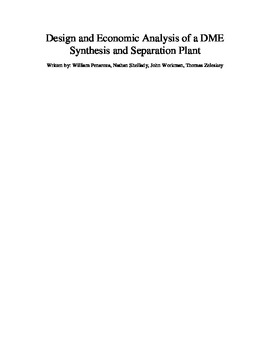| dc.contributor.author | Zeleskey, Thomas | |
| dc.contributor.author | Penaroza, William | |
| dc.contributor.author | Shellady, Nathan | |
| dc.contributor.author | Workman, John | |
| dc.date.accessioned | 2018-11-21T21:25:08Z | |
| dc.date.available | 2018-11-21T21:25:08Z | |
| dc.date.issued | 2018-04-10 | |
| dc.identifier | oksd_zeleskey_HT_2018 | |
| dc.identifier.uri | https://hdl.handle.net/11244/302138 | |
| dc.description.abstract | We performed a preliminary design evaluation of a process based around a PBR packed with the catalyst Amberlyst 35, which produced a DME product flow rate of approximately 250,000 gal/day, with a minimum product purity of 98.5 mass% DME and an estimated value of $2.32/gal, from a methanol feed stream of approximately 295,000 gal/day, with a product purity of 98% MeOH and an estimated value of $1.53/gal. Based on our economic analysis, we predict that our proposed process, over it�s 20 year project life, will result in a ROR of 65% with an NPV of approximately $141 million. This process will require an initial capital investment of approximately $20 million, with a payback period from 2018 to 2020. Based on our economic estimations we consider this process to be economically attractive. | |
| dc.description.abstract | In addition to the design of a Amberlyst 35 PBR process, we explored the application of reactive distillation using Amberlyst 35 to meet the design specifications of this project. We were able to appropriately simulate a reactive distillation process and analyze our results. Based on our economic analysis, we predict that the production of DME, as described in the design basis, by reactive distillation would result in an NPV of $182 million with an ROR of 240.5%. We found that the application of reactive distillation to accomplish the design basis, to be the most attractive of the two designs. The ability to separate the products from the reaction zone, through reactive distillation, and meet the design specification with a single column, significantly reduces operating costs and capital costs. Therefore, we recommend further detailed design of the reactive distillation process. | |
| dc.description.abstract | We found the specifications of our reactive distillation column to be as follows: The DME reactive distillation column is a single feed system with a methanol stream fed to stage 10 at the top of the reactive zone. The column has 8 stripping stages (including the condenser), 22 packed reactive stages, and 9 rectifying stages (including the reboiler). The column operates at a pressure of 139.1 psia and with a reflux ratio of 2.0. The catalyst holdup on each reactive tray is 66.8 lbm. This corresponds to a total holdup of 1469.6 lbm in the column. | |
| dc.format | application/pdf | |
| dc.language | en_US | |
| dc.rights | Copyright is held by the author who has granted the Oklahoma State University Library the non-exclusive right to share this material in its institutional repository. Contact Digital Library Services at lib-dls@okstate.edu or 405-744-9161 for the permission policy on the use, reproduction or distribution of this material. | |
| dc.title | Design and economic analysis of a DME synthesis and separation plant | |
| osu.filename | oksd_zeleskey_HT_2018.pdf | |
| osu.accesstype | Open Access | |
| dc.type.genre | Honors Thesis | |
| dc.type.material | Text | |
| thesis.degree.discipline | Chemical Engineering | |
| thesis.degree.grantor | Oklahoma State University | |
